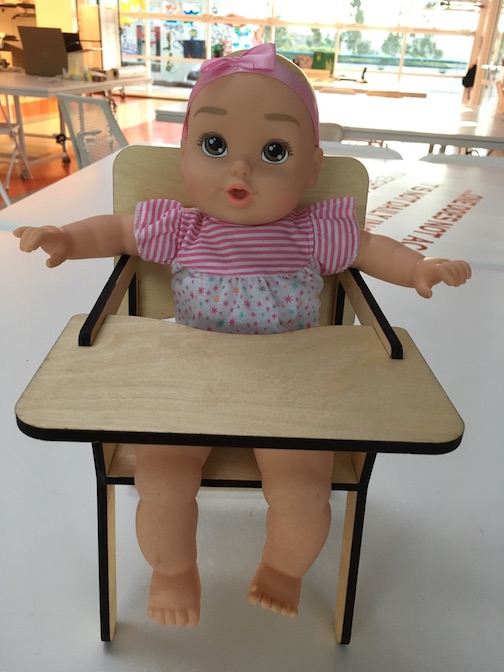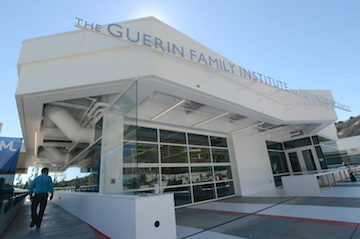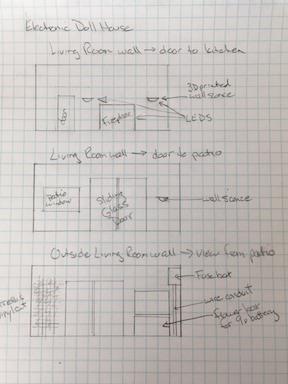1.Principles and practices¶
Assignment: Plan and sketch a final project idea
See my [Final Project page] (https://gitlab.fabcloud.org/academany/fabacademy/2019/labs/incitefocus/students/deborah-orlik/blob/master/docs/projects/final-project.md) for updates on this.¶
This week I worked on defining my final project ideas and started to get used to the documentation process. The picture you see below in the Gallery is of the Guerin Lab where I have had the pleasure of working every day since mid-August 2018. It is a huge space so we can accommodate many people at the same time. In addition to being a working fabrication lab, Guerin is used for meetings, social gatherings, our 3x year blood drive, and many other things.
For my final project, I have two ideas that will enhance what we do here at school as well as benefit others. Idea #1 is the easy-to-build toy idea. The second idea is the curriculum-for-all idea.
Easy to Build Toys¶
Early in the school year, I went on a field trip to local “sacred spaces”, among them a synagogue. The people there provide food for homeless and other people who cannot afford to feed themselves and their families. They also provide a space for children to play and learn. When children leave this space, they are invited to take a book with them. I was very touched by this because I am an advocate of teaching our children in many different ways. If we can make reading and math and other learning just like playing, children will do it with joy. So, I said to the director there ‘Let’s see if we can make wooden toys for you to give away in addition to the books.’‘ She thought this was a great idea! But as the weeks passed and I tried to come up with a selection of toys, the task became much more complex than simply making toys. How are homeless families going to carry large toys? Surely they have more important things to carry with them. How will they keep track of all of the pieces of small toys? All my toys seemed to be for girls; what can we make for little boys? The questions list got longer, but my list of toys did not.
Right now this seems like a pretty feeble project for a course where we will learn so many different things. But this is the problem that weighs on me, so that’s what I have right now. Perhaps, as Neil said, a great final project will come to me later. In the meantime, I will try to post some pictures of toys I believe we can fabricate quickly and inexpensively in our Lab and that can be distributed locally. Below, labeled Project Picture, you’ll see a toy high chair that can be made on a laser cutter/engraver for about $1. (I got the doll at Target for $10)
Project Picture¶

Final project preliminary thoughts: A doll house¶
The final project has to demonstrate “mastery”. It’s a master-piece. So I have to show many of the skills I learn along the way. My final project has to include 3D and 2D drafting, as well as 3D printing, laser cutting, electronics, and even the vinyl cutter. Molding and casting, too? I’m not sure. It has to be inexpensive to build - easily replicable - and show all of my plans.
Final project sketch¶
Final project blueprint¶
- Sliding glass door - maybe incorporate electronics that is a burglar alarm
- Fireplace - use clap on clap off board (from the sound electronic board) to turn the fireplace LEDs on and off
- Fusebox - make an electronic board that turns on all of the sconce light fixtures with an on/off button
- wall sconces - 3D printed
- Doll furniture - laser cut
- wall paper
Final project timing¶
Final project due date: 2nd week of June Electronics finish date: 1st week of June furniture (all laser cuts) finish date: before June 1 walls, doors, details: before May 25
The remainder of Week 1¶
For the rest of Week 1, I spent time understanding how to use this website. Using the internal interface is very easy so for now I will stick with that. I have done many years of website building – going all the way back to the 1990’s. I learned html by looking at other people’s websites, copying what they wrote, and then figuring out how to make it work with what I wanted to build. I also coded in dBase3 and built complex data base search frameworks. For example, I built a huge search function and hired coders to read witness testimony and code key words. An attorney could use this database with really fast searches during a deposition to ask the witness questions and cross reference that testimony with other witness testimony. By then, I knew I didn’t want to practice law … I wanted to update the practice of law.
To use the GitLab online interface, I have to log in with a password. I can type directly into the Edit File page in the repository. I keep the page on “soft wrap” so I can see what I have typed. I have learned to upload pictures through the “upload file” function and link them back to this page by typing in their address in the /images/ folder.
I have learned to link websites by putting the word to which the site is linked in brackets and putting the website url (including http://) in parentheses.
Along the way, I have also used other ways of building websites. My Idea Lab website is done in SquareSpace. I found it easy to use and inexpensive to maintain. The Idea Lab website is a good start for my Curriculum for All idea.
Useful links¶
Gallery¶

